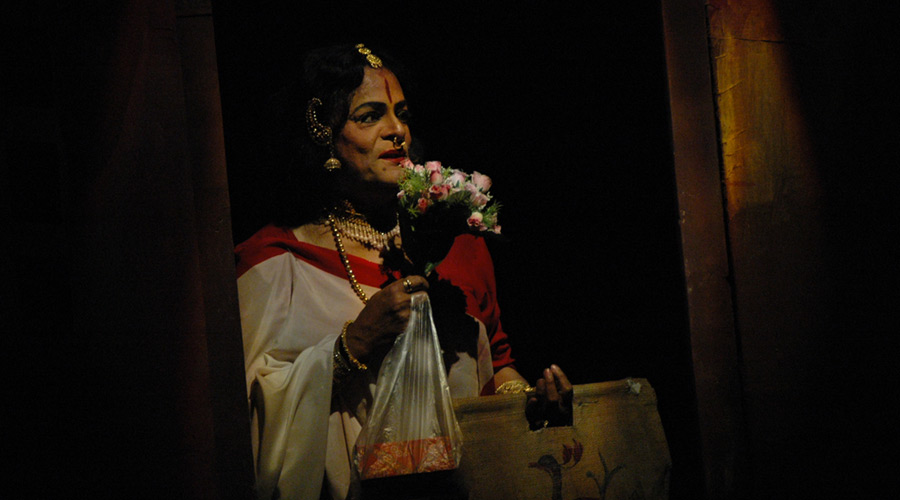Prabha Devi died and Chapal Rani was born. But I shall come to that later. This is the story of the last of the great female impersonators on stage. A doyen of the Bengali folk theatre form of jatra, Chapal Bhaduri, or Chapal Rani, ruled the stage between 1958 and 1974. He played Anjana in Raja Debidas, Amita in Sesh Arati and Iravati in Maharaja Parikshit. For the longest time, audiences spoke about his portrayal of Chand Bibi. In Mahiyashi Kaikeyi, he played a helpless queen instead of the fabled villainous figure; it is said that the play was written to give Chapal a meatier role. He became a household name and something of a style icon. As Raziya Sultana, he wore a net costume that created the illusion of baring more than it hid. In the 1960s, Chapal Rani was the highest paid jatra artiste, earning the princely sum of Rs 6,000 per month.
Eventually, in accordance with the laws of the universe, his fame started to wane. And here on he would have remained only half-remembered or mostly forgotten, had it not been for a determined fan and a recent photography exhibition.
Prabha Devi was a legendary screen, stage and radio actress of the 1920s and 1930s. She was married to theatre actor Tara Kumar Bhaduri. Chapal was their son. As a seven-year-old, when he debuted in Bindur Chhele, Prabha played his stage mother. The play was directed by his paternal uncle Sisir Kumar Bhaduri.
Prabha Devi’s death in 1952 left Chapal and his older sister Ketaki at sea. So when Chapal was offered the role of the slave girl Marjina in the play Ali Baba and Forty Thieves, the 15-year-old agreed, but only because it would ensure a daily-wage job in the Eastern Railways. It helped that he still had the high voice of a boy.
But when he quit the Railways three years later, Chapal’s voice was still high-pitched and it seemed only natural that he should don the sari on stage.
This would have been the late 1950s — shows were often hosted in remote areas where it was difficult to ensure the safety of women. Chapal has spoken about how once while rushing back to the stage from the greenroom he was abducted by four men. They let him go when they realised their captive was a man in woman’s clothing.
Chapal had started out with the professional jatra group Natta Company but later shifted to Nabaranjan Opera. His golden run continued. He put in a superlative performance in the play Michael Madhusudan as the poet’s mother Jahnavi Devi. The story goes that film star Uttam Kumar went backstage to congratulate the “lady”, and instead found a trouser-clad Chapal. Says the 83-year-old, “He was overwhelmed; he hugged me.”
Chapal also played the lead in thespian Utpal Dutt’s Jallianwala Bagh. By then women had started to tread the boards and in a few more years the roles for Chapal dried up. The spotlight would have moved away permanently from Chapal except for a chance meeting.
Sometime in the late 1990s, the actor happened to meet stage lighting director, photographer, publisher and fan Naveen Kishore in his sister Ketaki’s home. Ketaki Dutta had found fame in the Bengali commercial theatre circuit.
By then Chapal was eking out a living playing Ma Shitala, goddess of smallpox, in the lanes, bylanes and slums of the metropolis. Kishore captured Chapal’s fascinating transformation from man to goddess in a series of photographs. These were exhibited this August at the Chatterjee & Lal Gallery in Mumbai.
In 1999, Kishore also shot a documentary, Performing the Goddess: The Chapal Bhadury Story. This 44-minute film brought Chapal out of the cold, with films and plays being written about him. It also gave him the mantle of a gay icon.
When I see Chapal without make-up — in Kishore’s documentary because the octogenarian has only had his first vaccine shot — I am struck by how unfeminine he looks. Dark wavy hair brushed back from a broad forehead, strong jawline, prominent nose. Driven by curiosity, I look up photos of Sisir Kumar Bhaduri and discover that Chapal bears more than a passing resemblance to him.
Over the phone, Chapal could be any other old man whose voice has lost its depth with age. But he doesn’t sound frail and the timbre of his voice changes depending on the person he is quoting. “I don’t remember Chapalda being the least bit effeminate,” says Kishore, “except, of course, when he wants to be nyaka.”
Chapal was serious about his art; he put in inordinate amounts of hard work to turn into a believable woman. From the way he did his make-up to his collection of saris to mannerisms, the vibrant woman on stage was very different from the nondescript man in real life. He tells me, “I earned a lot.” Then adds, “But I couldn’t keep any of the money.” He is just as open about the loves and betrayals of his life. But he doesn’t sound bitter, just resigned.
Chapal lives in an old age home near Hatibagan in north Calcutta. Kishore’s documentary gave him a new lease of life, creatively and financially. It ensures the spotlight returns to him every once in a while, like it did with the exhibition. The next time the spotlight returns to him, writer journalist Sandip Roy would have finished writing Chapal’s biography.
Our man says, “People will get to know all about me from it.”











